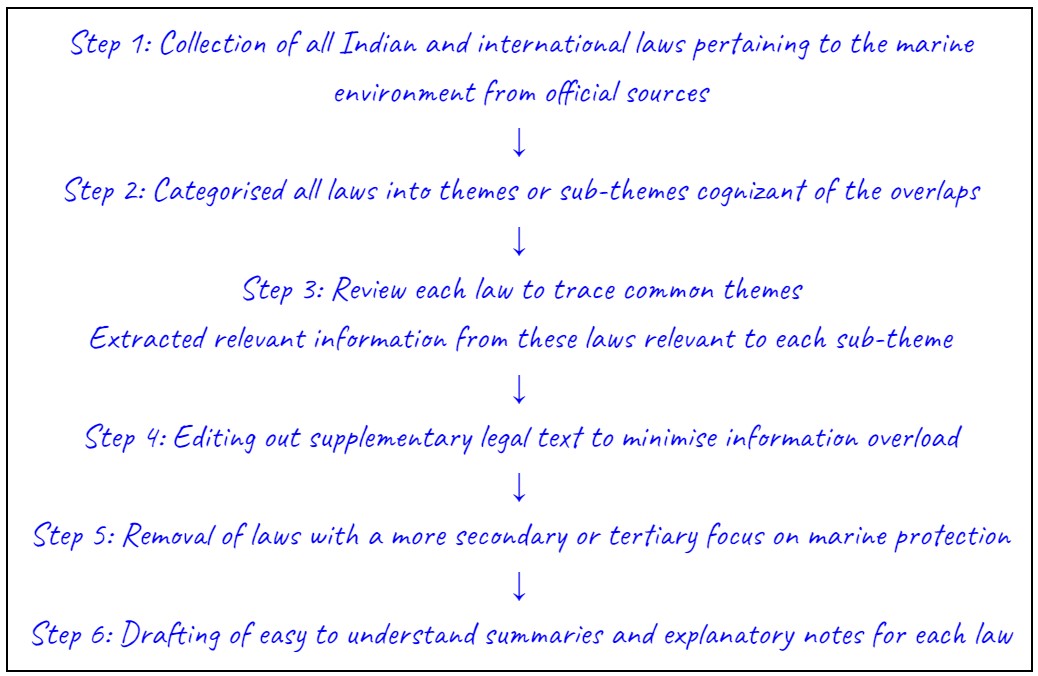Mapping Laws and Policies on Marine and Coastal Governance -An Explainer
This blog recapitulates the extensive consultation and brainstorming exercise the members of the legal team including Samrita Shankar, Shivani Swami, and Shubhra Sotie conducted during the policy mapping exercise, to design and launch the output in a more user-friendly, versatile, and accessible website format
India has a plethora of laws that govern the protection of coastal and marine biodiversity and species, of which the Wild Life (Protection) Act, 1972, (WLPA) is the most widely known and used legislation. However, other laws also provide for protection and conservation of coastal and marine ecosystems and species. For instance, the Environment (Protection) Act, 1986 (EPA) and notifications under it allow for the restriction of industrial activities in the coastal regions. Under the Biological Diversity Act, 2002, Biodiversity Heritage Sites may be declared in ecologically fragile or biodiversity rich areas. In light of this extensive law and policy framework, we felt a need to conduct a legal mapping exercise to help identify the key provisions of laws and their functions, which can further help a variety of stakeholders with evaluation research, legal analysis and policy development.
Originally, the plan was to incorporate the results of the legal mapping exercise into a report. Several drafts of the report were created along the way. However, the report was beginning to look dense and non-interactive, not to mention our concern with its foreseeable irrelevance as laws and policies get regularly amended. After extensive consultation and brainstorming, we decided to collaborate with the BlueMAP-India team at WCS-India to design and launch the output in a more user-friendly, versatile, and accessible website format. We believed that this could be a sustainable and evolving resource for the marine conservation community.

Going a step ahead, we also designed an interactive map of Marine Protected Areas (MPAs) in India, feeding into the policy section. This would allow our users a more immersive and fruitful understanding of India’s marine protected area network. However, developing a comprehensive repository of marine laws and policies is a complex and nuanced task that requires careful planning and extensive research - something that took us a couple of years to do. Here, we broadly lay out the steps undertaken and resources consulted to carry out the legal mapping of marine laws and policies in India as featured on BlueMAP-India.
In the preliminary phase, we collated all Indian laws and policies pertaining to the marine environment from the official government website for state and central acts (www.indiacode.nic.in/) and other central websites. The objective was to visualise the extent of legal protection and enforcement afforded to the protection of marine ecosystems in the country. To encapsulate a broader and comprehensive outlook of the marine environments in India, we also decided to include international marine laws and policies which India is a party to, from recognised international sources.
With the objective of making environmental policies more comprehensible and meaningful for citizens and practitioners, we categorised all collated marine laws with overlapping focus areas (such as the protection of areas, and species, and regulating commercial activities) into sub-themes to facilitate ease of understanding.
The next step involved reviewing each marine law and policy to trace common features and develop sub-categories or sub-themes to further break down information into bite-sized clusters. This involved a painstaking process of carefully extracting and noting relevant information applicable to respective sub-categories and meticulously editing out the supplementary legal text (available for open reading on the web). Laws and policies were re-reviewed and cross-checked to ensure their relevance and appropriateness in the marine environment. Acts with a more secondary or tertiary marine protection focus were, on a case-to-case basis, either removed or edited to best represent their applicability in the marine context.
Once compiled, the acts and policies were organised into a structured and user-friendly format, with a drop-down feature to minimise information overload enabling the audience to find specific laws and policies based on their needs easily. Finally, summaries and explanatory notes were drafted to introduce each policy under respective themes to offer prefatory context and enhance understanding.
We are appreciative of the fact that after years of trying to find a way to communicate the legal and policy framework governing coastal and marine biodiversity in India, the BlueMAP-India portal has made it possible. After all, the ‘P’ in BlueMAP-India stands for policy. While we are aware that there are several other portals where one can find a similar mapping exercise on laws and policies, the illustrative and interactive manner in which we have exhibited the information is rare. We hope that through this momentous endeavour, more and more stakeholders can become aware and sensitised about the laws of our land.
Shyama Kuriakose and Arghadeep Das



Diana Torres
Rassa id neque aliquam vestibulum morbi blandit in fermentum et sollicitudin ac orci phasellus egestas tellus velit ut tortor pretium viverra suspendisse potenti nullam ac tortor eu turpis egestas pretium.
Diana Torres
Rassa id neque aliquam vestibulum morbi blandit in fermentum et sollicitudin ac orci phasellus egestas tellus velit ut tortor pretium viverra suspendisse potenti nullam ac tortor eu turpis egestas pretium.
Diana Torres
Rassa id neque aliquam vestibulum morbi blandit in fermentum et sollicitudin ac orci phasellus egestas tellus velit ut tortor pretium viverra suspendisse potenti nullam ac tortor eu turpis egestas pretium.